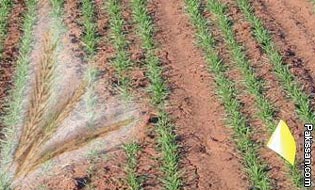|
Timely planting for increased wheat productivity
Home
By M. Naeem Mushtaq & M.
Saleem
WHEAT, a major staple food crop, is cultivated over an area of
8.3 million hectares while its share in agriculture is about
13.7 per cent. It accounts for nearly 40 per cent of the
cropped area and 65 per cent of the food grain acreage.
About 80 per cent and 20 per cent of the total wheat acreage
is planted under irrigated and rain-fed conditions,
respectively.
The current yield per acre is much lower than India and
China. A wide gap exists between the national average yield
(26 maunds/acre) and potential yield (70 maunds/acre).
Pakistan can become self-reliant in wheat production by
following a rightful production technology.
The low yield phenomenon is due to management and agronomic
factors which farming communities ignore. Among several
factors responsible for low yield, late planting is one. It
has been evaluated that wheat sown after November 25,
results in yield reduction by 15kg per acre per year.
According to a survey about 50 per cent farmers sow wheat
crop after this date. Late plantation is the result of late
crushing/harvesting of sugarcane and cotton crops due to the
conflict of interests between the mills and farmers. Each
side tries to reap bonanza but none is benefited. This leads
to late wheat sowing thus effectuating a sharp decrease in
production. According to a rough estimate, about 25-30 per
cent of wheat yield is reduced due to late sowing.
Mostly wheat sowing is completed by December or January but
the crop whether planted in November, December or January
matures at the same time. Therefore, the crop planted in
December/January can not complete its growth stages and
bears less number of tillers and grains. Likewise, most of
the wheat cultivation in Punjab and Sindh is done on area
pre-occupied by cotton, rice and sugarcane crops. In cotton
belt farmers continue picking still in December due to late
maturity of cotton varieties. Breeders have done a great job
regarding development of early maturing varieties of cotton
but still there is a need to have varieties which will
complete their growth and mature up to mid of November, so
that wheat can easily be planted in those areas. Here, relay
cropping of wheat could be a sound way to tackle this
problem.
Wheat is sown on standing cotton crop using broadcast
method. Cotton is allowed to grow and harvested after taking
last picking by end of December or first week of January.
This results in timely sowing of wheat and additional
benefit from cotton yield is also possible. Likewise, fine
rice is cultivated in most of the rice growing area. Under
such conditions, selection of early maturing varieties of
rice could be a best strategy to resolve this problem.
Timely planting (in the month of November) yields promising
results in terms of enhanced productivity of wheat.
Environmental conditions at this time favour proper seed
germination and thus lead to healthy crop stand that reduces
the chances of insect pests attack and weed problems. More
number of tillers per unit area and increase in leaf area
are instrumental in increasing the yield due to efficient
utilization of solar radiation in photosynthesis. Moreover,
plants receive required length of time for different growth
stages, from germination to grain filling and consequently,
the yield potential of crop plants is enhanced
significantly.
In addition to this, shortage of canal water at the time of
sowing is another obstacle. Most of the canals remain closed
when water is badly needed by the farmers for sowing wheat.
In “warabandi” system it is difficult for farmers to manage
timely irrigation when their respective canal is closed for
a weak or a couple of weeks.
Optimum availability of water to farming communities should
be ensured at the sowing time of wheat crop. It can be done
by shifting the closeness of canals to any other period of
time when water requirement is not so critical for crop
plants. In addition, more strategies could be effective for
reaping optimum yield like:
•There should be an incentive in terms of subsidy in inputs
like seed, fertilizer and herbicides for farmers who
complete their wheat planting in November.
•There should be fixed timeframe of cane crushing through
implementation of some regulations to bound sugar mills to
start cane crushing for ensuring timely plantation of
forthcoming wheat crop.
•A campaign should be launched by the Agriculture Extension
Department to create awareness among the farmers regarding
benefits of timely sowing of wheat.
•In future, early maturing varieties of rice and cotton
should be introduced to resolve these issues on sustainable
basis.
•Optimum availability of water and other inputs should be
ensured during sowing of wheat to facilitate the farming for
accomplishing this task effectively.
•There should be a provision of technical assistance to
farming community to follow respective production
technologies according to time and space.
.
Courtesy: The DAWN
|
Pakissan.com;
|